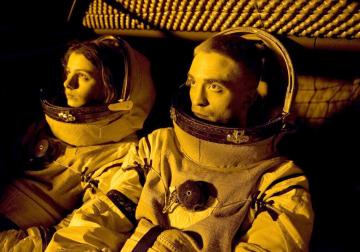Low lights on the 'High Life' spaceship, but Pattinson's good
In vitro veritas, I always say.
Somewhere in a time and galaxy not far away in the dystopian future, a toddler in a playpen is cooing and babbling to a man in a spacesuit on a monitor. When she starts to cry, he has to stop what he’s doing outside and tend to her.
Inside, under the eerie artificial blue light, he looks like he’s in prison garb — and might as well be. Such is the “High Life” and nearly solitary confinement on airship No. 7, four years into a mysterious mission.
- Starring: Robert Pattinson, Juliette Binoche, Mia Goth.
- Rating: R for disturbing sexual and violent content including rape, nudity and language.
Airship No. 7 has the unlovely design of a Chinese cargo container. Don’t look for nifty buzzers and bells on the control panel — there isn’t one. Unlike HAL 9000 in “2001,” the all-controlling computer here doesn’t even have a voice. No. 7 is a low-tech, no-frills spaceship with cold concrete hallways like those you might find in a mental hospital. No amenities here. Nothing organic, aside from a misted hydroponic garden where fruits and veggies are grown. There’s just some strange laboratories and sleeping cubicles for the “crew” — a motley one, consisting of Monte (Robert Pattinson), the closest thing to a pilot; Dr. Dibs (Juliette Binoche); and four or five youngish men and women — all looking pretty stressed.
Come to find out, much later in writer-director Claire Denis’ screenplay, some earthling in authority had the bright idea of recycling human beings. Selected criminals were given a chance to redeem themselves by volunteering for guinea pig duty in an interstellar human reproduction experiment — while hurtling towards their final destination: a black hole in which time and space cease to exist.
This is a lot to have on your mind.
And ship No. 7 is a lot like an intergalactic sperm bank, with dysfunctional donors and recipients making frequent deposits and withdrawals. There are many anger-management issues. More precious bodily fluids are involved here than in anything since Gen. Jack D. Ripper obsessed about same in “Dr. Strangelove.” Says the director: “The film is about sexuality, not sex. … Sexuality is all about fluids. … ‘High Life’ speaks only of desire and of fluids … of many taboos about our own bodies, intimacy and incest.”
There’s graphic sexuality and violence galore, rape, beatings, stabbings and masturbatory methods that put Woody Allen’s Orgasmatron in “Sleeper” to shame. The main one is — well, never mind, it’d never get past the censors. What used to be called “marital aids” are involved. Babies come out of microwave ovens.
Bottomline: “High Life” is not for the faint of heart or stomach. My companion spent a fair amount of the running time covering her eyes. Many walkouts were reported at the film’s Toronto Film Festival premiere due to the graphically disturbing and provocative images.
Mr. Pattinson, of “Twilight” saga fame, is excellent. (Denis originally wanted Philip Seymour Hoffman for the role.) As the slightly mad scientist-in-chief, Binoche (an Oscar winner for “The English Patient”), is likewise fine. But they’re all working against the handicap of Denis’ ponderously philosophical script, which has more black holes than the universe. The flashbacks and time-sequence jumps are confusing and the minimalist dialogue so whispery as to often be unintelligible.
Denis is a great director (from her debut picture “Chocolat” in 1988 through “35 Shots of Rum” in 2008 and “White Material” in 2009). This is her first English language film after 13 features in French — she has said she couldn't imagine people speaking French in space, only English or maybe Russian. It owes much to Kubrick’s “2001” — but, then, so does every other space film ever made since. She avoids special effects as much as possible, deliberately doing away with the weightlessness issue on the grounds that the spaceship is accelerating close to the speed of light — at which terrestrial gravity would reestablish itself.
I have no idea if that’s scientifically true, but it sounds good.
What LOOKS good is the world’s cutest baby, who deserves a long-term contract, at least till she’s three. She’s the most humanizing thing in the film. To whom — on the airship — does she belong?
The crew’s suffering is grim. The power of Monte’s conviction in his mission is great. The dirty little suggestion beneath it all is that, beneath thousands of years of human “progress” lurks something more savage than high-minded.
It’s a grotesque hybrid of science fiction and horror. It’s an hour and 50 minutes long, but seems longer. Someone says the spaceship’s travel gives “the sensation of going backward while moving forward.”
The same can be said for the movie.
Post-Gazette film critic emeritus Barry Paris: parispg48@aol.com.







